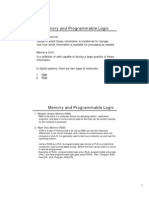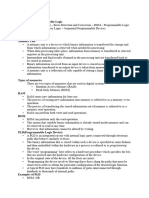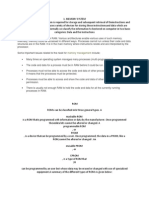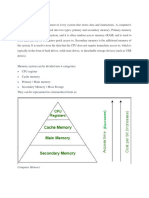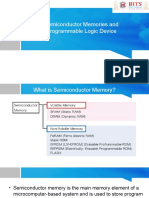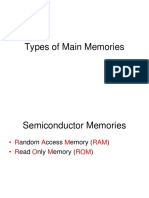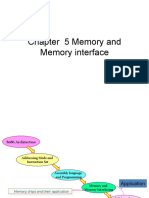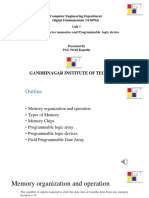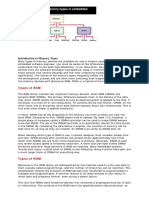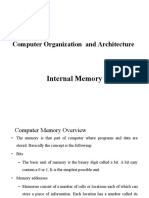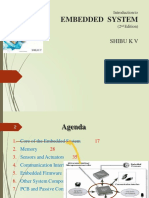0 ratings0% found this document useful (0 votes)
63 views70 pagesData Structures
data structures chapter 5
Uploaded by
Sam AmulyaCopyright
© © All Rights Reserved
We take content rights seriously. If you suspect this is your content, claim it here.
Available Formats
Download as PDF or read online on Scribd
0 ratings0% found this document useful (0 votes)
63 views70 pagesData Structures
data structures chapter 5
Uploaded by
Sam AmulyaCopyright
© © All Rights Reserved
We take content rights seriously. If you suspect this is your content, claim it here.
Available Formats
Download as PDF or read online on Scribd
You are on page 1/ 70
ee a
Memories and Asynchronous
: Sequential Logic
SYLLABUS
Memories : Introduction, Random-Access Memory, Memory Decoding, Error Detection and correction
Read-only memory, Programmable Logic Array, Programmable Array Logic, Sequential Programmable
Devices.
Asynchronous Sequential Logie = Introduction, Analysis Procedure, Circuits with Latches, Design
procedure, Reduction of state and Flow Tables, Race-Free state Assignment, Hazards, Design Example.
Concept of basic memory structure
Study of RAM cell, organi
0, working of SRAM and DRAM
Study of ROM cell, organization and types of ROM
Introduction to programmable logic devices
SEN EAE A
Circuit implementation using PLA, PAL ond ROM
<
3
&
3
2
$
2
=
3
3
a
2
g
3
zc
¥
8
3
£
<
Analysis and design
Y Concept of Cycles and Races
V- Types of hazards and hazard free relations
Y ” Design example of Asynchronous Sequential Circuits ‘
used to transfer it whenever. needed for processing.
\ary information and
4d in digital system are ROM and RAM. RAM stores
‘Memory units store the bin
It's a collection of cells. Memories that
PLA, PAI
ore vse!
Information for later use. ROM, Lare the programmable logie devices.
al crits contain « combinational circuit ond delay elements. These delay
“Track loop Sinee, cock i absent, the design of circuit i a bit
4d 10 any other circuits. Asynchronous sequential
tables and flow tables. The races caused in the
Asynchronous sequenti
tlements are connected to form a feedbac!
complex but speed of operation is higher compare
\d designed using transit
yhent techniques.
drevits can be analyzed an
crevits are reduced by race free state assignt
7 ‘ a TENTS. LSTenTOS
MN INEERING STUDENTS
180
51 MEMORIES.
Si introduction’
Qt. Discuss about types of semiconductor
: momory?
Ans:
Semiconductor Memory
A physical device used for encoding, storing
and retrieving information is known as memory.
Semiconductor memory is an electronic.deviee used
to store data and also used as computer memory. It is
referred as primary memory, as CPU usually accesses
information from it (code and data).
Read Only Memory (ROM)
Read Only Memory is abbreviated as “ROM”.
It is a memory device which stores the binary data
‘permanently irespective of the power status i.e, whether
it is ON or OFF. It is non-volatile in nature.
The figure below represents a ROM
inputs ‘n’ outputs.
Pen
ROM
Figure
In POM, the binary data is written only once
during the manufacturing process. In general, the data
‘once written cannot be erased.
The various types of ROM’s include, PROM,
EPROM, EEPROM and flash memory.
1. PROM
Programmable ROM(PROM) is one time
programmable non-volatile device. In this, the,
programming is done by connecting the required
fuses. .
Initially the memory contains all logic O's.
Wherever logic ‘1’ is required, that fuse is
connected by passing high voltage pulse. PROM
is less reliablé when compared to masked ROM.
EPROM
Erasable Programmable ROM (EPROM) is
a memory device which can be programmed
repeatedly by erasing the previous data,
‘The data is erased by exposing the entire chip
{0 ultraviolet light for a specified time. Then the
programming can be repeated.
EEPROM
Electrically Erasable Programmable ROM
(EEPROM) is a memory device which can be
programmed repeatedly by erasing the previous
data using electrical charge.
In EEPROM, specific bytes of the datg can be
erased one at atime,
Ly +s outputs
“inputs
(Gata)
(eddeess)
*
3.
+
DIGITAL ELECTRONICS [JNTU-HYDERABAD
Flash ROM
“This is also a memory device which is used
‘erase and program the selective portion of th,
data
Ithas an in-built single transistor circuit, which
enables the block of memories to érase by
consuming less power.
4
°
Random Access Memory (RAM)
‘The memory unit in which transfer of information
tor from any random memory location uses same access
time is known as Random Access Memory (RAM). tis,
volatile in nature. _
| Based on the mode of operation, RAM ICs are
classified as,
1. SRAM
‘The RAM in which stored information is valid
only when power is available is known as static RAM,
It uses flip-flops which require atleast 4 to 6 transistors
(hold only 1 bit of data) in order to store data. It does
not require refreshment of memory unit as data can be
retained until the power is ON. Since it uses cache RAM,
its speed of operation and power consumption is high.
Ithas less packing density.
NVRAM
Non-volatile RAM (NVRAM) isa random access
memory which is used as data memory to store the
information when power is tumed OFF. Itcan function as
both SRAM and EEPROM. Its contents can be retained
‘even if the switch is reloaded or power is turned OFF.
It continuously monitors V., by using control circuitry.
When V,,is less than the tolerant conditions, the circuitry
switehes automatically to its internal power source
and hence retains the NV-RAM contents, Therefore it
requires battery backup. In NVRAM, byte level erasing
‘of memory alone is possible with low accessing speed.
2
DRAM
The RAM in which binary information is stored as
¢lectrie charge on capacitors is known as dynamic RAM
In this, capacitors are used as data storage elements
which reduces the using of number of transistors to buil
the cell. It fequires refreshment memory unit to restore
the data. The packing density of DRAM is high, since,
ituses main memory its speed of operation is moderate.
‘The power consumption of DRAM is high.
3.
The semiconductor memory is widely used
as main memory digital processing system which is
classified as shown in figure.
WARNING: Xerox/Photocopying of this book is a CRIMINAL act. Anyone found guilty is LIABLE to face LEGAL proceedings.
Classification of Sericenducter Memery
“whatare the primary types of memories in
digital systems, and how do programmable
fogic devices like ROM and CMOS
FPGAS contribute to the design of digital
systems?
inst
Memory Unit
‘The memory unit is an essential component
ip igital systems for storing and retrieving binary
Eeraation for processing. During data processing,
‘Efomation stored in the memory is transferred to
Seale registers in the processing unit. Processed
‘is ae subsequently transferred back to memory for
(poage. It serves a5 a middle man for the exchange of
‘pformation between input and output devices and the
ces processing unit.
‘Types of Memories
Digital systems consist of two primary memory
types: RAM (Random-Access Memory) and ROM
(Read-Only Memory). RAM is utilized for read and
‘srt operations to store fresh data. ROM is utilized for
‘cessing pre-existing information, which can only be
rea, no altered.
Programming Logic Devices (PLDs)
Programming Logic Devices (PLDs) are
electronic components that can be programmed to
reform specific logic functions. They are commonly
‘ed in digital circuit design to implement complex logic
perations. PLDs offer flexibility and reconfigurability-
__ ROM is classified as a type of programmable
ltgic device (PLD). PLDs are integrated circuits with
ittemal logic gates connected through electronic paths
like fuses. In their original state, all fuses are
‘tc Programming a PLD involves blowing specific
eae along paths to create the desired logic function
Pe utttion. Other examples of PLDs include PLA
"erammable Logic Array), PAL (Programmable
y Logi eld Gi
Anup) “Bi and FPGA (Field-Programmable Gate
is complex internal sroctare. Maltiple-iapt OF P®
are symbolized by a single line ewer g te gee. #
By rs fee, ae depicted
(1). The graphical representation simplibes ete SPF
depiction and is consistently wtilized in aay lope
diagrams
=> HID
Conventional Amy logic
symbol symbol
Figare (Ni Conventional and Array Lope Diagres f°
‘OR Gate
(CMOS FPGAs
CMOS FPGAs stands for Complemerszry Meta
Oxide Semiconductor Field- Programmable Gate ASS
‘These FPGAs are configured by downloading 3 Sea
of bits into the device, configuring tensmission E255
to establish internal connectivity for a specified loge
function, whether combinational or sequential.
Array Logic Diagrams
In order to represent the internal logic diagram of
2 PLD concisely, a special gate symbology for exray logic
is employed. For instance, the representation of mukiple-
input OR gates involves single line exering the gate with
input lines drawn perpendicular to it, connected through
internal fuses. This graphical represectation is consistently
ese in my le ras oe om
5.4.2Random Access Memory, Memory
© Decoding 9
Q3. Briefly expl andom A
Briefly explain Random Access Memory
(RAM).
An:
RAM isan acronym for random 2ecess memory.
‘This type of memories can be used to perform both read!
write operations.
I is possible to access all the memory locations
in the RAM at the same speed to perform both read and
write operations. RAM is a volatile memory, hence
stores data temporarily. It stores data related to program
instructions and intermediate result of the program that
are used temporarily.
The data stored in the RAM can be read 2s many
number of times as possible. A new data, which is written
inthe any of the RAM locations, over-writes the existing
data present in those locations.
SPECTRUM ALLIN-ONE JOURNAL FOR ENGINEERING STUDENTS
182
The Nook tiara 0
Control lines
W address +
Hines Read Write
pio) 4
Memory units
(2 wonts)
mn! data output
lines
WW ddata
input tines
Figure
A random access memory unit contains input
Tines, output lines address selection lines and control
ines as Shown in figure
The *n? data input lines are used to write the
binary information to be stored in the memory, when
the control tine Write is active.
‘The ‘nr’ data output lines are used to read the
information stored in the memory, when the control line
Read is active.
The." address lines are used to select a specific
‘word location (among the 2! words of memory) to which
information has to be written or from where information
has to be read.
Salient Features of RAM
1. RAM is a volatile memory (i.
stored information on power cut).
ARAM basically performs two operations. They
are,
Read Operation: The process in which stored
information is transferred outside the memory is
called read operation.
Write Operation: The process in which new
information is stored into the memory is known
as write operation.
Based on the mode of operation, RAM ICs are
classified as,
Static RAM (SRAM): The RAM in which storéd
information is valid only when power is available
“is known as static RAM. It is usually made up of
internal latches.
Dynamic RAM (DRAM): The RAM in which
binary information is stored as electric charge
on capacitors is known as dynamic RAM
‘The discharge capacitor with time leads to the
discharge of stored information. By recharging the
capacitor the stored information can be retrieved.
Explain memory READ and WRITE
operation with neat timing diagram.
Ans:
, it looses the
@
@
Gi)
a4.
‘The two operations performed by RAM include,
1, Read :
2 Write
WARNING: Xerox/Photocopying of this book is a CRIMINAL
DIGITAL ELECTRONICS [JNTU. HYDERABAD)
Hen
The process in which stored information i
transferred outaide the memory is KHown as ‘regg:
‘operation
The steps involved in read operation are,
‘The binary address of the required data is applied
onto the address lines.
‘The read signal is applicd. This will take the bit
from the memory location and puts them on the
output lines.
Large integrated circuits consisting of several
memory chips, are provided with two control signals one
for chip selection using memory enable or chip select
and other to determine the memory operation.
| Ifmemory enable is low, chip is not selected and
IW operations arc not performed. If memory enable is
high, then read or write operations are performed based
on the corresponding input control signal. The memory
operations from these control inputs are illustrated in
table below.
Control inputs to memory chip
Meme | Ri | Memory operation
0 x =
1 0 | Write to selected location
1 1 _ | Read from selected location
2. Write
‘The process'in which new information is stored
into memory is known as ‘write? operation.
The steps involved in write operation are,
(The binary address of the required data is applied
onto the address lines.
(ii) The data bits to be stored are applied on the input
+ lines.
(iii) The ‘write’ signal is applied. This stores the bits
present on input lines to the specified address.
‘The two memory cycles that perform by the
RAM are write and read cycles. These operations can
be performed with the help of Memory Unit (MU) and
Central Processing Unit (CPU). CPU is an external
device which controls the memory operations. Since,
memory unit does not have its own internal clock to
control these operations. In order to select and read the
word, memory uses access time and to complete the
write operation it uses cycle time. CPU has to provide
control signal to the memory for internal clocked
synchronization with memory cycles. That means, when
the CPU is communicating with a memory its access and
cycle times will not exceed the time period of fixed CPU
clock cycles.
‘act. Anyone found guilty is LIABLE to face LEGAL proceedings.
_g; Memories and Asynchronous Sequen:
| Zaps an example in which the clock
1
su We
|i gis2oms ["* SO MHz wn the CPU is communicating with memory, then, its access and cycle times
| user eau c grad operations to terminate the storage ofthe selected word within
1 only 20 ns for one clock
» ycle, sires two-and-balf or
een cycle, Hence, it requires
183
frequency of CPU is 50 MHz. Then te time period of each elock
prt
8 ate three clock cycles for each word
ne waveforms :
fF timing waveforms of memory operation a
quis soi. Thus, the time period of mem
af ats are the three clock cycles of 20 ns
fe edon
inate write operation, CPU provides unit, inorder to ;
order to save data
se kept stable so thatthe memory can enable and geadnsie ee bring comet The address inputs
When! rian high level and read/write signals changes to low level, then the memory performs
ae operation ‘memory enable and read/write signal switches to the high level, then the memory
feos ead operation: Fig Feresenis write and read eycles along with ther timing waveform.
<— 20nsec —>
te shown in figures (a) and figure (b), in which clock frequency
on cycle and each clock cycle are $0 ns and 20 ns respectively.
post
Clock TI =) = =
Bee Address valid -
Memory ensble YF
Read/wtite — Initiate writing Latched
ea ©
Clock TI RD st a
Memory address ‘Address valid
Memoryenable—/\ cued =Sttst=“‘t‘ié‘s;<‘t‘i<«<
tite read
Reade ee
busca YT
(b) Read Cyele
Figures Timing Waveforms of Memory Cycle
“The address inputs have to be held stable for short time ({e, at least 50 ns) after deactivation of control
signals. Therefore, after termination of the third clock cycle, memory write cycle gets completed. Then, again CPU
‘2naccess memory and the next 7, eycle stars to operate for next selected word.
= Explain the organization of RAM with diagrams.
ns:
vie gM is an acronym for Random access memory This type of memories can be used to perform both read
ma eeation. tis possible'to access all the memory locations in the RAM at the same speed to perform both read
'wtite operations. RAM is a volatile memory, hence stores data temporarily. It stores data related to program
Pinas and intermediate resalt ofthe program that are used temporarily. Figure (1) shows the block diagram
"SPECTRUM @LLIN-ONE JOURNAL FOR ENGINEERING STUDENTS
184 DIGITAL ELECTRONICS [JNTU-HYDERABAD)
. Control lines ri
"tt address | ">
fines Read Write
- ‘n' data
input lines
[> ‘n’ data output
fines
Memory units
(2 words)
Figure (1)
Te gontains m-data input lines, data output fines, k-address fines and the control inputs (ie., Read and
Write), The *n* data input lines cary the information into the memory which is to Be stored and the r-data outpuy
lines carries out the stored information from the memory. The K-address lines selects the desired word from the
bi acoads available in the memory. The two control inputs performs the-desired operation on the memory ithe
ead input transfer the binary information into the memory and the write input transfer the binary information ow
Sfmemory. The memory unit specifies the total available words and their bits per word. The address line selects
one word mong the available words in the memory through a k-bit address. Address is an identification oumbs:
given to each word. Wher a A-bit address is given to the address line a particular word is selected with the help of
internal decoder from the memory.
“The size of the memories are changed greatly i.e 10-bit address is needed for 1024 words, 32-bit address is
needed for 2" words. Usually, the size of memory is represented in terms oF kilo(k) or Mega(M) or Giga(G) Bytes
Where Kilo bytes stores 2" (Le., 64k = 2"), Mega stores 2" (i¢., 2M=2") words and the Giga stores 2! (ic. for
4G = 2 words).
Figure (2) shows the content of 102416 memory where 1024 are
with 16 bits per each word i, 2 bytes.
the total words available in a memory
Memory adress
Bina Decimal Memory content “esata
0000000000 o 00h
0000000001 1 oth
‘000000010 2 o10n
nine: 1024 [reorretoearaTos) | aro»
sunninit6 1022 [oooor ror o0oT1 119} seen
iin, 1023 f fete ToooTeoTeT aPPn
igure (2)
Each word is identified by their decimal address i.e., from 0 to 1023 and the corresponding binary addres»
contains 10 bits. The binary address of first word is ten 0°s and the last word address contains ten 1"s (since, the 1025
decitnal address is equivalent to ten I's (1111111111) in binary). A particular word is chosen from the memory by
their binary address. When the word undergoes read or write, then the memory perform the operation on all 16-bits
like a single unit.
While in 64k x 10 memory. It contains 16-bit address and 10 bits per word. That means the number of bits
in address depends on the capacity of the memory (i.e, total number of words jt contains) and does not depends oF
the number of bits in each word. The number of bits in the address can be known from the relation 2'2 m.
Where, m — Total number of words
k— Number of address bits required to fulfill the condition.
‘to face LEGAL proceedings.
WARNING: XeroxiPhotocopying of this book is a CRIMINAL act. Anyone found guilty is LI
ee rentiate Static and
fe a
© raw the circuits of one eel ern
explain its working pri
inciple,
nces between Static RAM ang Dynamic k
e AM
fhe RAM in which
tored information is
,alid only when power
is available is known as
static RAM.
in SRAM. flip flops are
lysed as data storage
[clements.
are used as,
elements,
it does, not require
refreshment of memary
junit as the data can be
retained until the power
is ON.
The speed of operation
is high.
It is used for cache
RAM.
It has less packing,
density.
|The power consumption
of SRAM is high,
It requires refreshment
of memory unit to
Testore the data,
The speed of,
1 ©peration
is moderate,
It is used for main
memory,
It has hii
igh packing
density. +
‘The power consumption
of DRAMis less,
itis difficult to construct. | It is simple to construct.
It does not require
maintenance.
Itrequires maintenance.
10. [It is expensive.
SRAM Cell
Figure (1) shows the internal circuit diagram of
SRAM cell,
Bit line i
‘It is economical.
Bit line
Latch circuit
Word fine W
: Figure (1: SRAM Cell
“revit Description
The circuit of SRAM cell. contains three ee ae
aan two vertical as shown in figure (1). The
1 lines are’ parallel to each other and denoted by
; lines. The
srg, This Vertical lines are known as bit
SEotial ie is known a word line, ternal t0 these
SPECTRUM ALL-IN-ONE JOURNAL
Tne 185
ate two transi
Witha latch ee anitors which forme iP Connections
'WONOT gates
that, input of one
NOT gate becomes
ther NOT 7
Bate and vice versa
ACKOSS the ci
the transist
‘ors Femain in closed state. Hence the latch
SMCUM Fetains or holds their states
In order to,
made high,
the signal
Similarly t
fead the state 1 of transistors, “His
» a8 4 result the transistors get closed causing
{10 g0 high correspondingly i to go low.
© read state 0, /is made low with i’ to go high.
Morder to perform write operation i. changing
the transistors to the suitable states can te done by
iB appropriate values to bit lines i and i and
tivating the wordline. In this way, the state gets
stored in the latch circuit.
DRAM Cell
‘The working of DRAM can be described by
ing a single transistor DRAM which consists
consideri
of a single transistor and a single capacitor as shown
in figure (2) -
Word line
Transistor
Capacitor FS |
Bit line ee
Figure (2) A Single Transistor, Single Capacitor DRAM
‘The above circuit represents a single transistor
DRAM or a single transistor, single capacitor DRAM.
Here, the usage of capacitor is to store the charge ot
state of the transistor. Apart from the transistor and
a capacitor, the circuit consists of two perpendicular
lines, with horizontal line representing a “word line”
and a vertical line representing a “bit line’. The usage
ofthese lines can be observed during the working of the
cell. As the above circuit represents a memory cell, it’s
functionality is to either store or release the prestored
data. z
In order to store the data in the capacitor, the bit
line is fixed to a certain value which causes Some charge *
to get stored on the capacitor. On the other hand, while
retrieving the prestored value, the bit line is first charged
and the word line is activated, which causes the charge
to flow out from the capacitor through the word line.
FOR ENGINEERING STUDENTS
186 DIGITAL ELECTRONICS [JNTU-HYDERABAD|
Working
‘To store the data in the cell, the ch:
ON and applying an appropriate voltage to the
of current (measured in pico amperes). At the same time, the capacito
Teakage resistance. Thus, the data from the cell ean be read until the
be read, its
ther the capacit
arge must he stored in the capacitor. This is done by turning the transisty
tht line. When the transistor is turned OFF, it conducts small amoun
y atarts discharging, duc to this current and the
ischarge to some threshold value,
apacitor di
nsistor will be turned ON, Then, the sense
or'a charge is more than the threshold value,
‘This will fully charge the capacitor corresponding to logic
ae is Tess than the threshold value, then the bit line will be
1e of the capacitor corresponding to logic *0".
snever they are read. If data is to be read
ultaneously
When the data sfored in the selected cell is 10
amplifier which is connected to the bit line, checks whet
IF it is, then it will provide full voltage to the bit line.
1. If the sense amplifier finds that the eapacitor's chat
pulled to ground level, This will completely remove the charn
“The contents of a cell are automatically cleaved or refreshed wh
from a selected row, then the contents ofall the cells present in this row will be read and refreshed
G7. Explain memory decoding.
Ans:
Memory Decoding,
The process of selecting the ¢
storage space is known as “memory
“memory decodet™.
Basically, a memory unit requires both the storage components as well as the decoding circuits to ensure its
proper operation, The decoding operation ofa memory unit can be illustrated By ‘considering the internal construction
‘of RAM (Random Access Memory). .
Internal Construction of RAM 5 x ;
RAM is basically composed of m * storage cells associated witha decoding circuit (for locating individual
words). ‘
sHere, ‘m” and
Example _
The logical construction of a 16-bit RAM depicting the
he input address from a large memory area or
‘orrect memory word given by th
rms this action is known as a
decoding”. The module or circuit which perfor
| ¢>|
f
1
Decoder
Word 2
Memory —] EN
enable t - t
Word 3 t T +t
Read/write
OR gate
Output Data
ym of a4 x 4 (16-bit) RAM
Figure: Logi
WARNING: Xerox/Photocopying of this book is a CRIMINAL act, Anyone found guilty is LIABLE t0
LEGAL proceed
sae
cells. Since, A MeMOTY Of 4 wWorde
ns Tes, therefore, a 2 * 4 decoder ig
es eng operation of a code can be
ie memery Enable opt fe)
Reed two
employed.
abled or
IreN
aiathjecodet is enabled and depending on the inn
1g given, one ont of the four words ae selected If
28 oz all the decoder outputs turn out 10 be zero and
seord is selected:
When a word is selected, the read/write input
xonmines the type of operation (read oF write) ta
formed
When a read operation is to be performed, the
pits ofthe selected word are passed tothe oun
foo Pe through OR gates.
When a write operation is to be performed, the
jus present atthe input lines is given to the Binary
Ss(BC's) of selected Word. When no binary cells are
they are disabled, such that their binary values
remains unchanged.
samples of Memory Decoding Schemes
1, Atwo-dimensional coincident decoding scheme
is used in large memories for more efficient
decoding.
id
‘Address multiplexing is widely employed in
D-RAM integrated circuits.
How does the simplicity of DRAM cells
with one transistor and capacitor allow.
for higher memory density? Also, what
is the role of address multiplexing in
large-capacity DRAMs, using a 64K-word
. memory as an example?
Ans:
Introduction to Memory Cells
In Figure (1), the SRAM (Static Random-Access
Memory) memory cell is illustrated with six transistors.
However, for higher memory density, a different
approach is taken with DRAM (Dynamic-Random-
Accéss Memory) cells, which contain a single MOS
transistor and a capacitor. Despite the advantage of
higher density, DRAM cells require periodic refreshing
‘due to charge discharge from the capacitor over time.
Select
Bt |
= Output
Read/write
187
Input —>[BC}> output
Readwrite
ta (II: Memory Cell
Advantages of DRAM over SRAM
DRAMSs, with their simpler cell structure, achieve
higher density, enabling four times more memory
capacity on a chip compared to SRAMS. Additionally,
the cost per bit of DRAM storage is significantly lower,
making it a preferred technology for large memories in
Personal digital computers. DRAMS also have lower
Power requirements, contributing to cost savings.
Address Decoding and Multiplexing
Due to their large capacity. DRAMS use a two-
dimensional array for address decoding, often with
multiple arrays in larger memories. To reduce the
number of pins in the IC package, designers employ
address multiplexing. This involves using one set of
address input pins for both row and column addresses.
Ina two-dimensional array, the row address is applied
fist, followed by the column address, using the same set
of pins. :
Mlustration with a 64K-Word Memory
The text introduces a 64K-word memory
configuration, organized as a two-dimensional array
of 256 rows by 256 columns. This is illustrated in
figure (2). Address multiplexing is achieved through
two address strobes: Row Address Strobe (RAS) and
Column Address Strobe (CAS). The 16-bit address is
applied in two steps using RAS and CAS. Initially, both
strobes are in the high state. The 8-bit row address is
applied, and RAS is transitioned to 0, loading the row
address into the row address register. RAS also enables
the row decoder to select a specific row. After a settling,
time, RAS returns to the high state.
av
Bit column
“register
7m
eas totter ft tl et
¥
oan oat
\ddress Multiplexing for a 64K DRAM
SPECTROM ALL-IN-ONE JOUR!
NAL FOR ENGINEERING STUDENTS
188
Next, the §-bit column address
CAS is set to 0. This transfers the column address into the
column register and enables the column decoder. With
both parts of the address in their respective register
the decoders select the specific cell, and a read or write
‘operation can be performed. CAS returns to the high
state before initiating another memory operation.
51413 "Error Detection and Correction’
Q9, Explain about memory decoding error
detection and correction.
Ans:
Error Detecting and Error Correcting Codes
(The codes that are used to detect the presence
of errors caused by noise during transmission
through a channel are called error detecting codes.
Example: Parity code,
Gi) The codes that are ised to reconstruct the original,
error-free data are called error correcting codes.
Example: Hamming code.
S_Acode is said to be error detecting code only if
its minimum distance is two or more.
Generally, the errors are detected and corrected:
using a simple technique called Hamming code.
‘Hamming code use parity bits at certain portions
in the code. U
Aparity bit is an extra bit included with a binary
message to gnake the number of one’s either odd
oreven.
+. Parity check codes are used for detecting errors.
‘The parity bits are classified into two types,
namely,
1. Odd parity
- 2. Even parity.
1. Odd Parity: If the number of 1’s in the data to
be transmitted including the parity bit is an odd
number, then the parity bit is referred to as odd
parity.
2. Even Parity: If the number of 1’s in the data to
be transmitted including the parity bit is an even
number, then the parity bit is referred to as even.
parity.
‘© The limitation of the parity code with respect
to detection and correction of bit errors is that,
“Parity bit-is guaranteed only to detect an odd
number of bit errors ic., 1,3, 5...”
Ifeven number of bits is flippéd, the parity bit
appears to be correct even though the data is
corrupted.
DIGITAL ELECTRONICS [JNTU-HYDERABAD)
G10, Explain In detall the usage of Hamming,
codes for error detection and error
correction.
Ans:
4+ ° Hamming code is a technique used for detecting
and correcting errors.
4 Thistechniqué not only detects the errors butalso,
finds the exact bit that contains an error.
«© When digital information is transmitted from one
system to another system an error may occur due
to the presence of noise. As a result the digital
information may change from Oto I of vice-versa,
4 In Hamming code, in order to detect an error, a q
parity bit is added to the information that has to
be transmitted. a
4 This addition of parity bit makes the number of
1’s in information into cither even or odd. 4
4% At receiver, the parity bit present in received |
information is verified by comparing it with the |
transmitted information. i
“If it does not relate with the transmitted one an”
error takes place, then erroneous bit is corrected _
by replacing 1 by 0 or vice-versa depending on _
the error.
“The Hamming code can be generated by _
following the steps.
1. The number of parity bits used by the Hamming
code depends on the nuniber of data bits.
2. Its expressed as,
V2X+P+1
Where,
P—Number of parity bits
X—Number of data bit
Q11. With the help of the generalized form
of the Hamming code, explain how the
number of parity bits required to transmit
a given number of data bits?
|
An:
Hamming code comprises of certain parity bits.
The number of parity bits used by the Hamming code
depends on the number of data bits.
For example, the number of parity bits used by
the Hamming code for the given number of data bits are
given below, :
2PontP+1
Where, P —Number of parity bits and
n— Number of data bits.
For example, In a 4-bit Excess-3 message, the
Hamming code uses 3 parity bits (7 2° 4+ 3 +1
satisfies) for detecting and correcting the single bit errors.
Therefore, the total code consists of 7-bits.
parity bits can be placed in powers of;
‘Therefore, the general 7-bit Hammis,
sabi Exeess-3 MESSAZES i828 follows,
12,4,
imming code for
Di, Dis Dy Pu Dy P,P,
Where, D - Data bits and
P ~Parity bits,
Now, for the 4-bit Excess-3 message 1 ot 0
or Oare
esigned to the parity bits to forma 7-bit Hamming eo
copa
The parity bit P, checks the bits located at
a
jtions 1, 3, 5 and 7. So, P, should be ass
j ass
Fat bit locations 1, 3, S and 7 must have Giese
even of
ity. Similarly, P, checks for locations 2, 3, 6 and
Tand P, checks for 4, 5, 6 and 7.
Thus, a 7-bit Hamming code is generated for a
{bit Excess-3 message by assigning values to the three
represents parity bits.
Example: The given data bits are 0101.
The Hamming code can be generated by
following the steps.
Step 1: The data has 4 information bits. Then the
are,
Step 2: In this step, a bit location table is
Three parity bits aré required and to!
number of parity bits can be obtained by using
the expression,
2P2X+P+1
Where,
P —Number of parity bits
_X — Number of information bits,
Let, P=3
Then,
2 =P =Band
X+pt1=4434+1=8
2P > X+ P+ 1 condition is satisfied.
tal code bits
X+P=443=7
constructed
from the given code.
Parity Bit-p,
° ;
‘can be obtained by checking the bit locations
+3, S and 7. There is only one binary | in this
roup,
% So, P, should be replaced by *
Parity Bit-P,
©
Similarly P, checks bit locations 2, 3, 6 and 7.
There are two Is in this group for even parity.
* So, parity bit P, should be replaced by ‘0° for
even parity
Parity Bit-P,
© P,checks bit locations 4, 5, 6and 7. There is only
one 1 in this group.
‘ ” So, parity bit P, should be replaced by I for even
Parity.
‘The obtained parity bts are then replaced in the
bit location table.
Therefore, the generated hamming code is
101101
Qiz. Given the 8 bit data word 10111001,
generate the 12 bit composite word for the
Hamming code that corrects and detects
single errors.
Step
Ans:
Inorder to generate the 12-bit composite word for
the Hamming code we add four parity bits tot he 8-bit
data word. The 4 parity bits are located at position’s 20,
2!, 2? and 2? from left as shown below.
P,[P,]D,]P.{P.]P.]D, |] Pe|Po| Dio | Pur | Drs
1/ foal f:tololo
P, has to be selected such that bits 1, 3, 5, 8,7,
9, 11 have even parity ic,
P; 110110 must have been parity. So, P,
P, has to be selected in such a way that its 2,3,
6.7, 10, 11 have even parity ie,
, 11100 must have even parity. So, Py= 1+
"p, has to be selected such that bits 4,5, 6, 7, 12
have even parity i¢.,
011 must have even parity. So, P= 1
P, has to be selected such that bits 8, 9, 10, 11,
2 have even parity . So, P,
Word is 111101101001
71101101001)
DIGITAL ELECTRONICS [JNTU-HYDERABAD)
fe bit error occurred in each code
amming code. 1110111
“Julylug-24, (R18), QA(a) M9]
190
G13. Decode the following message assuming
word when it is transmitted through a no
0011011, 1101101.
Ans: ‘The message received is, 1110111001 10111101101 . z .
‘Since cach Hamming code is of 7 bits length. The received message can be segregated into four 7-bit words (received),
They are, 1. 110111 2. OOLTOIT 3. 1101101
The single error in each of these codes can be obtained as shown below:
that at mosta singl
isy channel using 7-bit H
LL Error in 111011
Bit designation > pe) PLP] Ps | | Pe | error code
His TTabalalalele
Received message 1 1 1 0 1 1 1
Cheek for P, (1,3,5,7) 1 1 1 1 0
Check for P, (2,3,6,7) 1 1 : 1 1 .
Check for P,' (4,5,6,7) 1 1 1 0 1
surred at bit position *4".
The error code is 160 that means error has occ
the actual code is 1111111.
Hence, complement the bit at position “4”. So,
2 Errorin 0011011
Bit Designation
Dy, Dy Pa Ds, saPays, Bun Biron cogs
Bit location, 7 eg ee el
1 18-101 100 ott 10,9
Received message 0.00 2b Oat 1
Check for P, (1,3,5,7) 0:7 1 0 1 °
[Check for P, (2,3,6,7) oo 0.0 1
QO. Os 1 al °
Check for P, (4,5,6,7)
‘The error is at bit position ‘2’. Hence,
So the actual message is 100101 1001100111001 100011001.
3. Error in 1101101
the correct message code is 0011001.
Bit designation | D, | D, | D, | P.-| Ps | Ps | Pi | Error code
_ [Bitlocation 7 silaeaig| se |e [et
th | afo ] sr | 100 | oir | oto | oo
Received message pfafofrfupofa
Check for P, (1,3,5,7) | 1 0 1 ‘ya °
Check for P, (2,3,6,7) | 1 | 1 Eto a
Check for P,(4,5,6:7) | 1 | 1] tft ' 0
The error code is 010 that means érror has occurred at bit position 2.
Hence, the correct message code is 1101111. ,
G14. A 12-bit Hamming code word containing 8 bits of data and 4
7 Parity bits is read from memory.
What is the original 8-bit word if the 12-bit read cut is 1010 1001 1101.
Ans:
- : AugJSep-21, (R18), 24) M7]
The given 12-bit Hamming code is, 1010 1001 1101.
Generation of 12-bit Hamming code involves 8 data bits and 4 parity bits. The bit pattern for the given data is,
[eT To Te To. Po. [oT To To
Lrtetifofifofofifil:
From the table, the data bits
., 8-bit word is, 11001101.
WARNING: Xerox!Photocopying of this book is
Logic
Generate the 13-bit co
bit compos
detects doubl errors, rn
sand 13 analy located at positions 1, 2, 4, and 8. These positions are
shy " are used for the original data.
ote ea Patty. Parity bits at positions 1, 2, 4, and 8 ensure an even
ans Consist of positions 1, 3, 5, 7,9, 11, and 13; positions 2, 3,6, 7 10.
Fi Positions 8, 9, 10, and 11. : ,
lata word: O1011011, : :
1-5:
Ue ven the B-bit data word O10T107
hat corrects single errors
_ pa 13-bit Hamming code, the extra
AE of 2. Bis 35.6 7.9, 1,11, 12, re
gilt pe additional bits’ values are det
sunt positions 4, 5, 6,7, 12, and 13;
‘Given Original 8.
p 1: Assign Positions
pl!
swPi"pi P2 DI Pa D2 D3
D4 P8 Ds. D6 D7 Ds PI3
more Ore OL et ot os
culate Parity Bits PI, P2, P4, P8: Party bi
step? C2 P2, D4, P8: Parity bits PI, P2, PA, and PB are calculated by performing XOR
Sens on specifi dt is a allows
PL=XOR G, 5.7.9, 1)=XOR(0,1,1, 1,1) <0
p2=XOR (3, 6, 7, 10, 11) = XOR (0,0, 1,0, 1
p4=XOR (5,6, 7, 12)=XOR (1, 0,1, 1) =1
pS =XOR (®, 10, 11, 12)=XOR (1, 0,1, 1)=1
sep3: Insert Parity Bits into the Data Word :
pl P2 DI P4 D2 D3 D4 Ps Ds-D6 D7 D8 PIB
prP2 0 P4 1 0 1 PRT oO 1 1. PB
oO. 0 1 10 1 ton 1. PB
P13 is a pari alculated over specific positions in the code word.
Calculation of P13
PI3=XOR of bits 1, 2, 3,4, 5, 6,7, 8,9, 10, 11, 12
P13 =XOR(I, 2, 3, 4, 5, 6, 7, 8,9, 10, 11, 12) :
P13 = XOR(O, 0, 0, 1, 1,0, 1, 1, 1,0,1, 1)
$0, P13 i8 calculated to be 1 based on the XOR of the specified bits.
Therefore, the final 13-bit code word is "0001101 110111," containing both the original data bits and the
calculated parity bits. é
Gig. Obtain the 15-bit Hamming code word for the 11-bit data word 11001001010.
‘Ans: Ina 15-bit Hamming code, the extra bits are usally located at positions 1,2, 4, and 8. These positions are
smliples of 2. Bits 3, 5, 6, 7,9, 10, 11, 12,13, 14 and 15 are used for the original data,
“The additional bits' values are determined by parity. Party bits at positions 1, 2, 4, and 8 ensure an even
‘umber of 1s in specific groups. The groups consist of positions 3, 5, 7, 9, 11,13 and 1; positions 3,6, 7, 10, 11,
Ii and 15; positions 5, 6, 7, 12, 13, 14 and 15; and positions 9, 10, 11, 12, 13, 14 and 15.
Given Original 11-bit data word: 11001001010 =
Step 1: Assign Positions
Pl P2 Di P4 D2 D3 D4 P8 DS D6 D7 D8 D9 DIO Dil
PLP) 1 Pa. dO OPE 0 OL OD. 8.
Step2: Calculate Parity Bits PL, P2, P4,P8: Party bits PI, P2; PA, and PB are calculated by performing XOR
operations on specific data bits as follo .
P1=XOR (3, 5, 7,9 11, 13, 15) XOR (1, 1,0, 1,0,0,0)=1
P2=XOR (3, 6,7, 10, 11, 14, 15 XOR (I, 0, 0, 0,0, 1,0)=0
P4=XOR (5, 6, 7, 12,.13, 14 15) XOR(1,0,01,0,1,0)=1
P8= KOR (, 10,11; 12,13, 14,15) = XOR(L, 0,05 10 D1
Step3: Insert Parity Bits into the Data Word
Pi p2 D1P4 D2 D3 D4 PS DS D6 D7 DS D9 DIO Dil
Meee a eeege de Dee 0: REIT, Oeste OH EAD
Te eR ey 9 TBO oO Ot PG :
‘Therefore, the final 15-bit code word is "10111001 1001010, containing both the original data bits and the
: |
FOR ENG! NEERING STUDENTS
‘SPECTRUM ALL-IN-ONE JOURNAL
192
i 5ALa" Read Only Memory
Q17. Whatis ROM? Explain tho operation of It.
Ans:
ROM .
Read only memory is abbreviated as “ROM
h stores the binary data
It is a memory device W
permanently irespective ofthe power status jc, whether
it is ON of OFF ic, it is non-volatile
Figure (1) represents a ROM with ‘nm
outputs.
inputs ‘a
RAE kot
Figure (1): ROM
TnROM, the bit
too during the process of manufact
written can’t be erased.
Operation of ROM
outputs
(ata)
ry data is written only once that
g. The data once
Here, the transistor is connected to ground by a
switch. Hence, whenever the switch is closed, the value
of the transistors switches to zero élse it remains ‘1’. Ii
order to read the status of a cell, the word line is turned
high. Asa result, ifthe switch of the transistor is closed, 4
value ‘0" flows out of the circuit. Similarly, ifthe switch
remains open, the transistor supplies a value ‘1”. There
is no write operation possible with ROMs, since data is
added to it only while it is being manufactured,
“ Q48. Explain the organization of ROM with
relevant diagram.
Ans:
ROM
For answer refer Unit-5, QU7, Topic: ROM.
‘The Basic ROM consists of a decoder of size
n* 2 and a memory array as shown in figure (2).
Decoder
Memory array 2*
nx2s
n input words < m bits
lines
m output lines
Figure (2)
DIGITAL ELECTRONICS [JNTU-HYDERABAD
inorder toi 1A oryanization, consider
an example of W208 ROM, A 3278 ROM cantains
input lines for address and # output fines. Ht prevvides
32. words, where each word represents # data bits, The
internal logic of a 927% ROM is as shore in figure (4,
CECH
5 +32
decoder
24 {
4, 29
30 eleE
_— uw
Figure (3)
This contains a 5*32 decoder. It decodes 5 inputs
into 32 different outputs, where each output provides the
address of memory. These 32 outputs are given to the
each eight OR Gates. So, each output of decoder acts as
an input to each of the eight OR gates. Therefore 322
gives 256 internal connections which are programmable.
When the two lines are connected intemally then it acts
as a switch that may be closed or opened. This meeting
point of two lines is known as crosspoint. Truth table
signifies the.binary information stored in a ROM. The
truth table illustrated in figure (4) specifies the binary
information stored by the ROM of size 32*8. It stores
32 words and size of each word is 8-bit. Each of the 32
word location can be accessed by 5 inputs J,, I,,
and /,. The words stored in all 32 address locations are
accessed by the outputs 4, 10 4,
Inputs Outputs
LUE A AAA AAA, Ay
©0000 10110110
00001 00011101
90010 11000101
Ooo1r tor 1roo010
1100 00001001
PDOs Neg he 9 20 (061 0
11110 ©1001010
LVittu oorroo yy
Figure (4)
WARNING: Xerox/Photocopying ofthis book is a CRIMINAL acl ‘Anyone found guilty is LIABLE to
LEGAL proceedinas.
A648 ROM is a combinational
The 6 inputs are called address inputs j
CUPUS and an erable input as shown in figure (1)
‘sre called as data outputs ie. AD,-AD_
4 ACA, 648
Enable input Rom [—>AD,-An,
Figure (1: 64. 8 Rom
The enable input (EN ) is an active low pin. When an active low Signal is applied to this pin, the 64 « &
ROM store the truth table of 6-inputs, outputs combinational logic function.
312 = 8 ROM is implemented by using cight “64-8 ROM" and a 3-4 decoder to enable one of the eight
“648 ROM” chips ic., an 3%8 decoder selects one of the eight ROM chips depending on the three input bits. Thus,
toully there are 9 input bits which provide the required 512 x 8 ROM configuration as shown in figure (2),
A, 0 -
a 1
a—
near}
38 3
i 4
EN.
ia oer es Scie ew : ;
i it "64 x BROM" Chips
: IM by using Eight “64
sare BE tion of 512 x BRO ; -
Figure mle using @ ROM tha accepts 22 Bt number and generates an
- a ‘ el corm mumber equal to the square of he gi
utput binary i!
i f input would be the
Ans: . 3-bit mimber as input and square of
“To design a combinational circuit which Stan abc dean8f a5 he abs.
pt
Sutput, consider x, y and z as the 3-bits of the RNAL FOR ENGINEERING STUDENTS
SPECTROM ALLAN-ONE J00
194
Table
The logic of the combinational circuit is given in
the table.
The output is square of the input number.
It can be observed from the table that minterms
for the output expression obtained are as follows, .
Em(6, 7)
Em4, 5,7)
Em(3, 5)
Em(2, 6) 7
Em(1, 3, 5,7)
The block diagram of the combinational cireuit
using 8 x 4 ROM is as shown in figure (1).
‘ a
x 8x4 b,
y ROM “
z p—d
|O—e
f
Figure (1): Block Diagram
The circuit implementation using ROM is
illustrated in figure (2).
0 -————__——_+——_
1
x 7
3:8 0093 i.
¥™) Decoder 4
2 5 1
6
7
Y
ab le. diie..'f
Figure (2) : Combinational Circuit Using ROM
WARNING: XeroxiPhotocopying of this book
DIGITAL ELECTRONICS [JNTU-HYDERABAD]
Q21. Explain different types of ROM in detail,
Ans:
ROM
For answer refer Unit-5, Q17, Topic: ROM.
Advantages
4 Itis more reliable than RAM
© Itis non-volatile
The data stored in it is permanent and cannot be
changed
% Itis cheaper than RAM
Iisa static memory so it does not need to refresh
each time,
‘% _ Ithelps to boot the operating system.
Disadvantages
It is very slow
Itis capable of only reading the data
‘It is unable to store large amounts of data
% Ifchanges are required in data it is not possible.
The different types of ROM are,
1. Programmable Read Only Memory (PROM)
2. Erasable Programmable Read Only Memory
(EPROM)
3. Electrically Erasable Programmable Read Only
‘Memory (EEPROM)
4. Flash Memories
1. PROM
+ Programmable ROM(PROM) is one time
programmable non-volatile device. In this, the
programming is done by connecting the required
fuses.
‘Initially the memory contains all logic 0's.
Wherever logic ‘1° is required, that fuse is
More costlier than other ROM chips.
4 Flash Memory
This is also a memory device which is used to erase and progfam the selective portion of the dato.
@ — Ithasan in-built single transistor circuit, which ‘enables the block of memories to erase by ‘consuming !ess
power.
Advantages
Flash devices have greater density
4b High capacity and a lower cost pe Bit
4. Uses only single power supply voltage:
& Consumes less power.
Disddvantages
They are prone to damage physically
% ‘They are slow since they rewrite every block of da
‘ es a) jh the flash memory 19 DEO" 8 card, casing itto be used with a variety ‘of applications.”
ese are used 16 patel ee .
They are now sealable with several memory S17°S like 8, 32, and 64 Mbyte:
a" 7 4
wort Hada : isk drives. But it's storage capacity is less than Giga byte. However,
io renee an insensitivet0 vibration.
These are developed
* they have high speed ‘of operation, ©
aos DIGITAL ELECTRONICS [JNT!
Q22. Differentiate RAM and ROM.
YDERABAD)
Ans:
The differences between RAM and ROM are mentioned below:
ROM RAM
1, ]Read Only Memory (ROM) is a combinational] 1. [Random Access Memory (RAM) contains
circuit [sequential circuits elements called flip flops.
2. [ROM allows data to be written only once and read] 2. [RAM allows data to be read and written any number
Jany number of times. of items.
3. | The general block diagram of ROM is, 3. | The general block diagram of RAM is,
; Address bus, ————
n inputs —o |» m outputs — Data bus
Read ROM K=>
Write >
4
Chip select
4. |ROM isa non-volatile memory. 4, |RAM is volatile memory.
S. ROM is used for permanent storage. 5. RAM is used for temporary storage.
6. ]ROM is less expensive than RAM. 6. |RAM is much expensive than ROM.
7. ]ROM is a low-speed memory. 7. |RAM isa high speed memory.
8. | The size of ROM is larger than RAM. 8. | The size of RAM is smaller than ROM.
9. |ROM stores critical programs for example the] 9. |RAM stores operating system application programs
[program that boots the computer. and data or currently running processes.
10. | Types of ROM 10. | Types of RAM
\) Programmable Read-Only Memory (PROM). (i) Dynamic Random Access Memory (DRAM).
Gi) Erasable Programmable Read Only Memory (ii) Synchronous Dynamic Random Access
(EPROM). Memory (SDRAM).
|Gii) Electrically Erasable Programmable Read (iii) Static Random Access Memory (SRAM).
‘Only Memory (EEPROM). .
(Gv) Flash memory. ‘
“Table
Q23. Given a 32 x 8 ROM chip with an enable input, show the external connection necessary to
construct a 128 x 8 Rom with four chips and a decoder.
Ans:
32% 8ROMisacombinational circuit with S-inputs, 8-outputs and an enable input as shown in figure (1). The
S-inputs are called as address inputs ie, 4,- A, and 8-outputs are called as data outputs i.e., AD,- AD,
AA, 328 [=p a0,-An,
KOM
Enable input EN,
Figure (1)
The Enable Input (EN ) is an active low pin. When an active low signal is applied to this pin, the 32 «8
ROM will store a truth table of 5-inputs, 8-outputs combinational logic function.
To implement 128 x 8 ROM, we need four “32 « 8 ROM” and a 2 = 4 decoder which has to enable one
of the four “32 x 8 ROM” chips ie., we can use an 2 4 decoder, which will select one of the four ROM chips
depending on the two input bits. Thus, totally we have 7-input bits which will provide the required 128 x 8 ROM
‘configuration as shown in figure (2).
WARNING: Xerox/Photocopying of this book is a CRIMINAL act. Anyone found guilty is LIABLE to face LEGAL proceedings.
197
ROM CHIP L
Figare (2)
a the operation of 16-bit ROM array with neat diagram.
ans 1A 16-bit ROM is constnucted (bedel Paper, atta) |Apty 23. 1, 21010) ED
"using an array of memory cells, each capable of storing a single bit
cont
«ot Te ea elas in ows and cohimns, forming the ROM array. The adress tines, also known
gether ae icular coh pif row inthe array, hie the deta lines, sso own the columm
sos. elect * an aaa pee ROM array is as shown in figure. To choose any one of the 16 bits
we ges (Ay a Av Ay) red Te lowe ro A ooh Mecoder DL
er ile the higher order two bits (A, A.) are decoded through the decoder DH eat
the 4 column sen: ic t
and con sense alii. The dade mati # mde y comes ‘one diode with a switch
non :
in address
a
3 Column
Data output
Figure
FIGINEERING STUDENTS
GONE JOURNAL FOR FI
198
Memory Ga
The memory cells in a 16-bit ROM are
implemented using electronic switches, typically
transistors, which can be cither in an “on” state
(representing a logical high or 1") or an “off” state
(representing a logical low or “0”), These cells are
fanged in a grid-like fashion to form the ROM array.
Address Decoding
To access a specific memory location in the ROM
array, the desired address is provided to the address
lines. The address decoding, ry within the ROM
uses Combinations of logic gates to decode the address
and determine the corresponding row and column to be
accessed.
Control Signals
The operation ofa 16-bit ROM is controlled by
various signals, including the chip enable (CE) signal,
‘the output enable (OE): ‘signal, and the write enable (WE)
signal. These signals help regulate the data flow and
enable the ROM to perform its intended functions,
Working Principle of a 16-bit ROM.
The working principle ofa 16-bit ROM involves
the retrieval of stored data based on the Provided address.
When an address is input to the ROM, the address lines
are activated, causing the corrésponding row address to.
be selected. Simultaneously, the column address Jines
enable the desired column within the selected row.
Read Operafion
During’ a read operation, the selected memory
cell in the ROM array activates its data line, allowing
the stored information to be accessed. The output data is,
then available on the data lines for further processing by
the system. This read operation is essential for retrieving
relevant instructions and data stored in the ROM array.
Working of 16-bit ROM Array
For illustration the diode D,, is connected in
betweén column 1 and row 2. The output is enabled
through applying logic 1 at the CS input that is chi
select. Programming a ROM implies to selectively open
and close the switches in seric’s along with the diodes.
For illustration, if the switch of diode D,, is into closed
position and if the address input is 0110, the row 2 is
activated linking this to the column 1. As,well the sense
amplifier of column 1 is enabled that provides logic 1
output if the chip is selected means C:
as logic 1 is stored at the address 0110. Conversely, if
the switch of diode D,, is open, logic 0 is stored on the
address 0110.
WARNING: Xerox/Photocopying of this book is a CRIMINAL act. Anyone found guilty is LIABLE to fa
DIGITAL ELECTRONICS {INTU-HYDERABAD
5.1.5 Programmable Logic “Array,
é Programmable Array Logic 3
025. Write a brief note on PLDs,
Ans:
Programmable Logic Devices (PLDs)
A programmable logic device is an int
logic circuit which is user. ‘Programmable. It is ‘basically
composed of programmable gates arranged in the form
of AND array and OR array.
Based on the arrangement of programmable
ates, PLDs are divided into three types. They are,
() Programmable Read Only Memory
(PROM)
Gi) Programmable Logic Array (PLA)
(ii) Programmable Array Logic (PAL),
() Programmable Read Only Memory (PROM)
PROM is a combinational PLD with fixed AND
array and programmable OR array as shown in
figure (1). The fixed AND array is constructed as
a decoder whereas the programmable OR array
Provides the implementation of boolean functions
in the form of sum-of-minterms.
a Fixed AND A | Programmatic A. onere
>| ray (Decoder OR array
Figure (1)
Gi) Programmable Logic Array (PLA)
A programmable logic array is a combination of
Programmable AND array and programmable
OR array as shown in figure (2). In this device,
the product terms of AND array can be shared
with OR array for SOP (Sum of Products)
implementation.
Iapus—+ Progammable | rrogrammabie Ay o
a ‘AND anay ORarray
Figure (2)
(iii) Programmable Array Logic (PAL)
A programmable Array Logic (PAL) formed
by combining a programmable AND array and
a fixed OR array as shown in figure (3). The
Programming of AND array provides the product
terms for boolean functions.
1. It shows
ts—p-| Programmable A | fined A 5 oupins
Tipo emer aes .
igure (3)
LEGAL proceedings.
199
4 logic diagra
Draw the gram of progra
G26 gic array. Explain its operation eee
ns
Ane" ene Programmable Logic Array (PLA) jg
LA) is a
‘ device, contain
ational logic ¢ + containing a two fe
senna “AND" and progranmable “OR ay !
re PLA does not perform complete decoding A
ji ag and does not produce all the minterms. The
sane’
eooder iS replaced by an array of AND gates,
‘The block diagram of PLA with ‘m* inputs and
gcouuts i 8 shown in figure (1),
combi
ec |
1 I
2%" |programmable| }. [Programmable
gt y ft
BL] aNDamy OR array
=z
fe Wy
k word lines n output lines
, Figure (1): PLA .
The PLAS are programmed’in order to achieve
sm of product logic expressions.
In PLA, an array of AND" gates produce the
oduct terms of the applied inputs, and an aray of “OR”
eesproduce the “sum of products” logical expressions
Ferexample, a
PO+PR
OR+PR
PO+PR '
PR
Then, the corresponding PLA programming table
isshown in table.
Product | Inputs Outputs
Term [pg r[f ff %
PQ, [Lr ef ed@
ar |- 0 1f/0 1% ©
peer ora ee 4
rr fo - ofo tt @
Table: PLA Programmable Table
structure of PLA fort!
‘The intern
ial gate level
‘ons is as shown
ing
SPECTRUM €l
Figure (2k: Internal Structure of PLA
___ The inputs, P, Qand R are applied to the buffer
inverter combination to produce its complement. The
respective values are given as input to the AND gates
to produce the “product terms”.
‘The outputs from the ‘AND array are given as
inputs to the ‘OR’ array. Thus, the output produced by
the ‘OR’ gates is the “sum of product” terms.
Applications
1. These are used to implement control over a data
path.
2. Theregularstructure of PLA’s with programmable
AND and OR array’s isused in complex systems
involving many variables.
3. PLA’s are used to perform programmable logic
sequencing and finite state machine operations
with the registers at input and output
27. Explain detail about PAL and PLA.
Ans: __ Novibee7 (R15), 010
Programmable Logic Array
For answer refer Unit-5, Q26.
Programmable Array Logit
‘The block diagram of programmable array logic
i as shown in figure (1)- z
Fixed OR
amy
"Figure (1k: Block Diagram
‘The Programmable Array Logic (PAL) is a
programmable logic device which is constructed using
programmable AND arty and fixed OR array. AND
rey is provided to give product terms which are
fopically summed using OR array. PAL- is easier for the
programming Purpose.
Inputs dm Ourputs
agg ‘and four outputs Boolean expressi
= ENTS
LL-IN-ONE JOURN FOR ENG! EERING STUDI eS
intr ex semen Seca 2p Eo Sm Pe dura
seth Sanus Sx duwe pg
ABE
Ane PAL
eur. tn
emg. OR spas at ay SR
DIGHTAL ELECTRONICS NINTUNYDERARAD)
cack term mmet be
Fagurs (2) : PAL mich Faur inguts, Frur Gutzuts and 2 Tiree Wide AND-O5 Sroctore
Figure (2) represents 24 pus $ come
open (say FF Fy md Fy. Each inp coe
PAL is sed ta desien dizi 2
2 Wis widely used ie VLSI cious and yseems.
G22. Compare PAL and PLA with respect to various performance features.
4.5. Cand D) ant ker
The caper de of pFRal
guesand a Grad OR exe,
AND goss using fires Som caqpet seco
ace also known as progmmmmad LO PALS
imation. :
‘The compasison of PROM, PLA and PAL is mentioned below.
f PLA
PAL ]
1. | PLA is a programmable device which is used to] PAL is 2 programmable Gove WHR BETO
implement combinational logic circuits.
2. | The design consists of programmable AND array and
programmable OR. array.
3, | It is more expensive.
4, | PLA is difficult to program.
5. | In PLA, AND arrays are programmed to obtain desired
minterms.
6, | It is more flexible to program AND array.
7. | It is used for implementing any Boolean functions,
implement combinational logic circuits,
‘The design consists of programmable AND and
fixed OR aay.
Itis inexpensive.
PAL is simple to progam.
In PAL, AND arrays are programmed to obtain
desired minterms.
Itis less flexible to program.
It is used for implementing any Boolean
fictions.
8. | AND array are programmed to get desired minterms. | AND arrays are programmed to get desired
WARNING: Xerox/Photacopying of this boak is a CRIMI
minterms.
‘act, Anyone found guilty s LIABLE to face LEGAL preceediogs.
memories and Asynchronous ge,
You might also like
- DF GTU Study Material Presentations Unit-5No ratings yetDF GTU Study Material Presentations Unit-544 pages
- Basic Memory Operation: Static RAM, SRAM: An SRAM Is More Expensive and Less Dense Than DRAM. It Uses ANo ratings yetBasic Memory Operation: Static RAM, SRAM: An SRAM Is More Expensive and Less Dense Than DRAM. It Uses A3 pages
- Computer Hardware: Input, Processing, and Output DevicesNo ratings yetComputer Hardware: Input, Processing, and Output Devices69 pages
- Commonly Used Memory Chips, ROM As A PLD: Duration: 60 Min Digital Electronics Branch: EE 2022-26No ratings yetCommonly Used Memory Chips, ROM As A PLD: Duration: 60 Min Digital Electronics Branch: EE 2022-2627 pages
- Materials For Memory and Display SystemNo ratings yetMaterials For Memory and Display System56 pages
- Memory Organization UNIT 3 - TOPIC 3.1 (PART 1)No ratings yetMemory Organization UNIT 3 - TOPIC 3.1 (PART 1)9 pages
- 14-Cache Memories-05-Sep-2018 - Reference Material I - Types of Main MemoriesNo ratings yet14-Cache Memories-05-Sep-2018 - Reference Material I - Types of Main Memories18 pages
- Semiconductor and Programmable Logic DeviceNo ratings yetSemiconductor and Programmable Logic Device35 pages
- William Stallings Computer Organization and Architecture 8th Edition Internal MemoryNo ratings yetWilliam Stallings Computer Organization and Architecture 8th Edition Internal Memory22 pages
- Computer Systems: Hardware (Book No. 1 Chapter 2)No ratings yetComputer Systems: Hardware (Book No. 1 Chapter 2)111 pages







